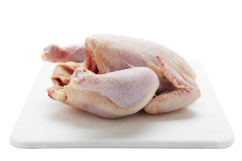The FSA’s year-long survey, which tested around 4,000 samples of whole chickens bought from UK retail outlets and smaller independent stores and butchers over the past 12 months, found the presence of campylobacter in 73% of chickens tested. One-fifth (19%) of chickens tested positive for campylobacter with the highest band of contamination (more than 1,000 colony forming units per gram (>1,000 cfu/g)).
Just 0.1% (five samples) of packaging tested positive at the highest band of contamination with 7% of packaging testing positive for the presence of campylobacter.
All of the major retailers failed to reach industry targets to reduce the bug over the period of the study. Tesco was found to have the lowest numbers of campylobacter, with just 12.8% of its chickens found to have the highest band of contamination while 66.5% of its chickens had presence of campylobacter.

Marks & Spencer, Morrisons, Sainsbury’s and Tesco all had below-average levels of campylobacter found, while 80% of Asda chickens tested positive for its presence. Just under one-third (29.7%) of Asda chickens tested positive for the highest band of contamination.
Steve Wearne, FSA director of policy, praised the retailers that had reduced incidents of campylobacter but called for more action: “I am absolutely delighted to see the really encouraging results from these four supermarkets and their suppliers. They are making a real difference to public health, helping to cut down on the estimated 280,000 people who get ill from campylobacter each year.
“As we have always said, if you are prepared to work across the food chain to reduce the spread of this bug then you will get results.
“I want to challenge those retailers who haven’t yet demonstrated the effect that M&S, Morrisons, The Co-op and Waitrose are having on reducing campylobacter on chickens on their shelves. We expect all retailers and processors to be achieving the reductions we have seen in these retailers’ figures – that’s the only way we will meet the target we all signed up to.
“We are going to run this survey for a second year and will again look at campylobacter levels on chickens at retail sale. I hope that we will be able to see the results from the actions taken by the four retailers mentioned above and others come through and produce much lower figures for the incidence of campylobacter on the chicken we buy.”
Richard MacDonald, chair of the ACT (Acting on Campylobacter Together) board, added: “I have been impressed by the level of commitment and tangible action being taken by a number of retailers and processors of chicken. I hope we continue to see further progress in our fight to significantly reduce or even eradicate campylobacter on chickens. Individual actions and cross-industry sharing of best practice are starting to have a real and tangible impact.”
Commenting on the results, a British Poultry Council spokesperson said: “As highlighted by the FSA, individual producers and their retail customers are working bilaterally to trial options including enhanced biosecurity, management of thinning, improved processing, temperature treatments, and novel packaging. It is worth reiterating that campylobacter is killed by thorough cooking, and cross-contamination can easily be avoided by good kitchen hygiene practices.
“The BPC is committed to ensuring that when practical and effective solutions for beating campylobacter are developed, they will be made available to all producers.”
A new survey will start this summer and once again sample fresh whole chickens from all types of shops